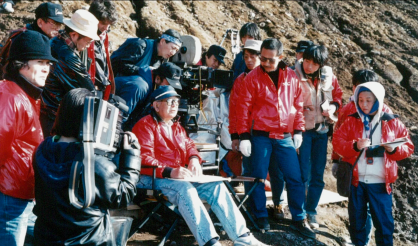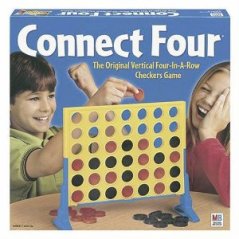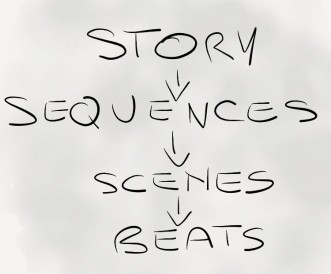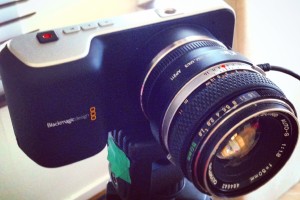 The one and only Teruyo Nogami, Akira Kurosawa’s Script Supervisor and life long collaborator. Her scripts look like they’re ready to be framed, so beautiful!
The one and only Teruyo Nogami, Akira Kurosawa’s Script Supervisor and life long collaborator. Her scripts look like they’re ready to be framed, so beautiful!
Please watch this interview where she talks about her work with Akira.
 The one and only Teruyo Nogami, Akira Kurosawa’s Script Supervisor and life long collaborator. Her scripts look like they’re ready to be framed, so beautiful!
The one and only Teruyo Nogami, Akira Kurosawa’s Script Supervisor and life long collaborator. Her scripts look like they’re ready to be framed, so beautiful!
Please watch this interview where she talks about her work with Akira.
A couple of months ago someone hash tagged me in a tweet that quoted something I had said during The Generation Next conference.
I felt incredibly flattered since I am not often quoted online; I don’t remember ever being quoted. Also because I am quite terrified of public speaking so I was surprised to have actually muttered something worth remembering. The truth is I really believe what I said. There we go, something I should keep in mind for future public speeches: speak honestly and some ideas might resonate with others.
Why this, now? I have just come across an interesting paper on collaborations and how important they are in the filmmaking process, how they can and should be taught to film students because they can make or break a project.
It’s a valuable read. I remember of a few projects that suffered because of communication problems or simply because the heads were not great collaborators.
And it’s also written by someone from my old university. Good one Kath Dooley from Curtin!
I was invited to take part in the Open Channel conference this year alongside other professionals in the industry. Thank you for the opportunity Open Channel!
 Do you know the game Connect Four? The players take turns to insert coloured discs in a vertical board aiming to have four of the same colour in any direction.
Do you know the game Connect Four? The players take turns to insert coloured discs in a vertical board aiming to have four of the same colour in any direction.
We were shooting a 3 minutes scene with two characters in a pub, talking, drinking beers and playing a game of Connect Four.
Any Script Supervisor’s nightmare scenario!
I approached the two actors to lock in continuity. I suggested keeping their business to a few moves to make it easier for them. But young Toby ran the scene with his acting partner and blocked about 20 moves. I wrote it all down on the side of my script, muttered a glum ‘good luck’ and went away to sulk by the monitors.
We turned over. First take: more or less as they blocked it. The director suggested a few changes in their performance. Second take: the new directions taken on board, but their actions the same. The two were subtly prompting each other in the game to maintain continuity. The director loved that so it all became part of the scene. Third take: a few performance changes but the actions were the same. The coverage was a breeze! Toby confirmed his moves with me before turning over and then he did it all the same.
What a relief… what a surprise! Some actors like to get extra busy in a scene but few can duplicate their actions. And there’s not enough time to shoot extra takes for continuity on TV shows. If the performance is good we move on, I pray the scene will be cut mainly in closeup and hope the audience won’t notice the changes in action.
“So Toby, how the hell did you remember it all?” His answer was ‘the key’ that changed the way I worked.
But I need to digress. There’s a simple method I now use to break down a script that helps me keep track of the story when I don’t get a chance to join the rehearsals.
Any story is a succession of dramatic beats leading to a conclusion.
In the film and TV world the script is our story. So the script can be broken down into sequences, the dramatic beats of the story. A sequence is a collection of scenes. There’s usually one scene in the sequence that holds the key for the dramatic beat. That scene informs the audience of a change in the story. And in that scene there’s usually one line of dialogue that holds the key. That key line or scene beat pinpoints to what the scene is actually about.
 I make it easier for myself and name the key scenes by their dramatic beat, like The Breakup scene, or The Goodbye scene, or The Meet-Cute scene (in rom coms), etc. In a meet-cute scene the romantic characters have their first encounter, most times disastrous. And it’s one line of dialogue that signifies to the audience that something will happen with these two characters. The characters might not understand it yet but the audience definitely sees there’s a connection.
I make it easier for myself and name the key scenes by their dramatic beat, like The Breakup scene, or The Goodbye scene, or The Meet-Cute scene (in rom coms), etc. In a meet-cute scene the romantic characters have their first encounter, most times disastrous. And it’s one line of dialogue that signifies to the audience that something will happen with these two characters. The characters might not understand it yet but the audience definitely sees there’s a connection.
So back to Toby. With each line in the Connect Four scene he was doing something to his acting partner that was leading to the key moment of the scene. He wasn’t just drinking beer and playing a game. He was punctuating his dialogue with his actions. He was drinking to delay an answer, he was playing to lose, he was covering his mouth to hide, etc. Each action supported the dialogue and was leading to the key line of the scene.
Once directors and actors identify the scene’s beats and the key line, the paradox is they have more freedom to play with the tone of the performance.
Toby, his acting partner and the director analysed the scene in rehearsals. They discussed what the scene was about (its role in the story, the dramatic beat) and they identified the key line that made the scene clear for the audience. Toby did his homework and came up with a performance choice. On set he showed it to the director. They agreed on a few small changes and they went ahead to shoot it. With this homework done Toby could adjust his tone or the intensity of his performance without changing his actions.
Since my chat with Toby, I started to notice that most continuity problems occur on sets where actors and directors didn’t analyse the script and had no chance to decide on a scene’s role in the story. Experienced actors somehow lock in their actions, even without intellectualising the scene. Less experienced actors though, don’t understand that adjusting their performance doesn’t mean shifting the let’s say ‘moment of realisation’ in a scene from one line to another. There’s just one line that gives them the ‘moment of realisation’. And when they know that line they do exactly the same movement or business every time. They pick up the knife, or turn around, or shift their body weight at the same place in the scene.
It’s the Director’s role to make sure the scene holds true to the overall story and it’s the Scripties role to make sure that each angle is continuous and once cut it will all flow. But to make my job easier, understanding the story and the scenes’ beats is adamant. It’s why I try to go to all rehearsals and when I can’t join the rehearsals I break the story down into dramatic beats and then try to confirm them with the Director. That’s how I know I can help my team the best I can and sleep better at night. Imagine if some of the crew went to rehearsals – how much easier would that be let’s say for a Focus Puller!
 A couple of years ago I was incredibly privileged to have a prototype of the Black Magic Pocket Camera on a music video I Directed. That music video ended up being a nightmare deal with the clients, but about that maybe in another post. That dreaded experience didn’t put me off seeing the potential of the tiny black box the size of a point and shoot holiday camera!
A couple of years ago I was incredibly privileged to have a prototype of the Black Magic Pocket Camera on a music video I Directed. That music video ended up being a nightmare deal with the clients, but about that maybe in another post. That dreaded experience didn’t put me off seeing the potential of the tiny black box the size of a point and shoot holiday camera!
A year later I bought my own Pocket Cam. I was Script Supervising a short film for Brown Cab Productions when I received it. So I took the camera on set to test it in my downtime. I only had an old style 50mm Olympus lens with no stabilizer, no sound gear, not even a tripod and only one memory card. I just wanted to take a few shots to see how it all looked like. And I was so captivated by it! Not only by the camera but by what I was discovering about my behaviour after all the years spent watching the on set monitor. This was real life, no script followed, and I still kept thinking about continuity!
Because I was on a long lens most of the shots were in close up. That forced me to think about coverage, to make sure I had more than just talking heads but also points of view, details of the action, I had to keep in mind how the reverse angles would cut with what I had already shot and how I would eventually put it together to tell a story. And continuity was always on my mind! There was an incredible freedom not having a script but my mind was still going back to the habits I formed all these years on set as Scripty!
Cutting the footage was about creating a mood with the shots I knew I had. And shooting all that footage with continuity in mind helped enormously!
Shooting that behind the scenes clip was a reminder that every shot had to be seen in the context of the story. This is something I find incredibly important when I’m on set. I try as much as I can to see every shot in the context of the scene and to imagine it cut with everything else.
It’s really easy to get lost in the details of the moment and to forget the big picture. Many posts by rookie Script Supervisors on the online help forums are about technicalities in their paperwork. Many want to know the RIGHT way to number a pick up shot or a reshoot, or stress about certain departments not wanting to set the correct time on a cast member’s hand watch. Many ask for THE way to do it. I’d say that as long as the editor gets a logical, consistent map of all the footage then THAT is the right way of doing it. And as long as all the shots make sense in the context of the story then the time of day incorrectly set on the actor’s hand watch makes no difference since that detail will never end up in the final cut.
At the end of the day our role needs to support the telling of the story. It takes time to get used to observing all the details, like watching the action on many monitors simultaneously while following the written dialogue and taking notes at the same time. But really, the best support one could offer, is through understanding the story and finding meaning in everything that’s being shot and always thinking of its context.
Shooting and cutting my own documentary material helps me understand what is essential when I’m Script Supervising. I also find it incredibly liberating to not follow a script and still, I always keep in mind what’s needed visually to tell a coherent story. I hope that more Scripties invest in some gear to shoot and cut their own footage. I recommend it!
The actual short film I Script Supervised when I got my Pocket Cam was screened at Sydney Film Festival a couple of weeks ago and its Director, Ryan Griffen, received a special mention in the Rouben Mamoulian Award for Best Director. Well done Ryan and the team! And here is the behind the scenes of You Turn, shot, edited, graded and everything else, by yours truly.
It’s been a while since I posted anything on the blog. Let’s just say that ‘life’ got in the way. But work is life and life is work, or better said I’m one of those who lives to work rather than works to live. Even when I don’t work I do something connected to it – and it doesn’t mean I compulsively rearrange all my books by size and colour (my books are already organised by theme and author, thank you).
So when there’s no work there’s just real life. Even though I have been through this many times to know to look for the next ‘fix’ before I get the cravings, that’s exactly when life kicks you in the guts as hard as possible for having neglected it, like an unsatisfied lover whom you’re really happy to see after a long separation but who in turn has accumulated all this anger caused by your absence. Me neglectful? Impossible! My latest personality test says that I’m the intuitive kind and completely in tune with others’ needs, a person who likes to please and help. No, it wasn’t a test in Marie Claire. It was a ‘legit’ website, with over 7 million tests done to date, which I totally believed since it also said that I was suitable for a career in television or writing.
I was at a party not long ago and someone said ‘Wow, I haven’t met anyone who said they loved their work so much! I want your job’. But it’s not a job, it’s a lifestyle! I am indeed one of those who never complains about too much work. I love it, it makes me happy and fulfilled, it’s what feeds me and gives me purpose! Everything else: just the ‘in-between bits’. And when the ‘in-between bits’ aim and kick you in the guts, then better to stick with what is safe and painless.
But when work completely forgets about me then I get to behave like the neglected lover, and I crave it, and I suffer and I would do anything for the next fix! The high is so good that I cannot bear the thought of a breakup.
Hi, I’m Sabi, and it’s been two long days since my last shoot…
Hi again,
After the last TV show I took some time off to shoot a music video, I went overseas to two weddings at the opposite ends of Europe, renovated my apartment in Bucharest in record time, and I am now back in freezing Melbourne for a few Script Supervision classes.
First up are a few talks at VCA for the 1st year Script Writing and Directing Students followed by on set coordination of their film projects.
Later in September on the 14th and the 15th I’ll be going back to Open Channel to teach the Script Supervision intensive course. It’s open to those who have some experience on set and dare to work as Script Supervisors. More on what’s offered read briefly bellow, and in more detail in an older post.
First day we’ll talk in detail about what a Scripty does in preproduction and during production. We will talk about script consultancy, breaking down and timing scripts, calculating shooting ratios; we will watch clips from various films and discuss blocking, coverage, eyelines, crossing the line, screen direction and camera angles; we will also discuss the relationship with the Director and the Actors, also the general ethics of working with the cast and crew.
Second day is of a more practical nature and we’ll focus on doing the Scripty’s paperwork. We will use the script and rushes from a project that’s already been broadcast. The students will time and breakdown the script, they will watch rushes and write the continuity logs as if they were on set, they will then simulate providing feedback for each take to all relevant departments, they will mark up the script for post production and they’ll do a DPR. At the end of the class we will watch the edited scene and discuss it from the Continuity point of view.
The interested need to register with Open Channel.
Hope to see you there!
I never make New Year resolutions and I don’t normally reflect on a year that just finished or time that passed.
But today I had to create a 2013 Continuity Folder and noticed the first Work Folder I ever created titled 2003. It’s been a long time since then, and those very first two projects I did as Script Supervisor: the feature The Course which really taught me the job and the pilot shoot for “Tomorrow When The War Began” which almost got me kicked out of university and nearly stripped me off of my Best Student of the Year Award for accidentally burning down a forest just outside Perth in WA.
The university officials understood that a forest regenerates over time so here I am, 10 folders later, creating a new one and already saving into it two fresh scripts ready to be broken down – in fact this is the 11th folder since 2003 but that’s just a technicality.
To all of you, I hope in 2013 you get to catch the big fish, same as I did, and maybe it’s a Dhufish like mine!
The other day I stumbled upon this sweet website that made use of a few Film Continuity rules in a really fun and creative way!
Eternal Moonwalk is a quirky online tribute to Michael Jackson. It’s a simple crowdsourced website that asks its contributors to send videos of themselves moonwalking through frame. The clips are then randomly played to create the illusion of one continuous moonwalk.
The clips, of course, are as diverse as the countries of their submitters. So to create the illusion of a continuous walk the web makers ask everyone who submits a clip to adhere to a few cinematic rules, the very rules used to match moving action on screen. When the submissions stick closely to the rules, the clips match better and the walk looks smoother – kind of. The basic cinema rule used on this website is a Continuous Screen Direction. So just by applying these simple rules to something you shoot you can hope for a smooth, continuous cut.
– Start the action OFF SCREEN – this will establish the screen direction, in this case Right to Left; starting with an empty frame makes for a smoother cut
– Use the same shooting style – in this case they ask for a static shot; it’s harder to match clips that use different shooting styles; a hand-held shot won’t cut well with a static shot so it’s safer if all clips use the same shooting technique
– Shot Size – in this case because of the randomness of the clips they ask for a full body shot; if the entire person is on screen then the web makers can ensure a more or less similar lens size and a better match from shot to shot
– Continuous action – same action for every clip; if a character is running in one shot we expect him to keep running in the next shot
– Finish the action OFF SCREEN – the character exits frame camera left; we expect him to appear in the next clip from camera right; because each clip starts with a character entering frame from camera right we can assume that the walk is never-ending
The website had tens of thousands of submissions. At the top of the clips there is a counter measuring the length in kilometres moonwalked continuously by people, animals, vegetables and really random objects. The clips are quirky, different and some really inventive. There is no other continuity between clips except the rules just mentioned. What really makes this website work, is the continuous screen direction – everything moves from Right to Left. It’s not a smooth walk and no one would believe it is so, but these clips are really fun to watch. Some of them are quite surprising! Enjoy!
Revistă de cultură cinematografică editată de studenții la film din UNATC și distribuită gratuit.
wander as you wonder
Reviewing Australian Blu-ray releases including Umbrella Entertainment, Imprint Films and more!
Only selected advertising
UCF Film
Notes on the Voluntourism Industry
Blogging About Psychotherapy from Chicago
cusaturi, planse de lucru
cu dragoste pentru portul stramosesc
urban informality + urban development
Just another WordPress.com site
Script Supervision with Sabi Paisa
Writer, speaker, consultant
watch my work
Art & Design Choice Cuts
Save toddler Amira's life and help her beat acute myeloid leukemia.
film in all its forms
Script Supervision with Sabi Paisa
Script Supervision with Sabi Paisa
etimpu.wordpress.com I Blog Nostalgic , Amintiri din Copilarie , Amintiri din Epoca de Aur
A documentary film revealing untold stories from the 20 year long war in Northern Uganda between Joseph Kony's Lord's Resistance Army (LRA) and the Ugandan Government Under Current President Yoweri Museveni
Melbourne's Property Market Uncovered